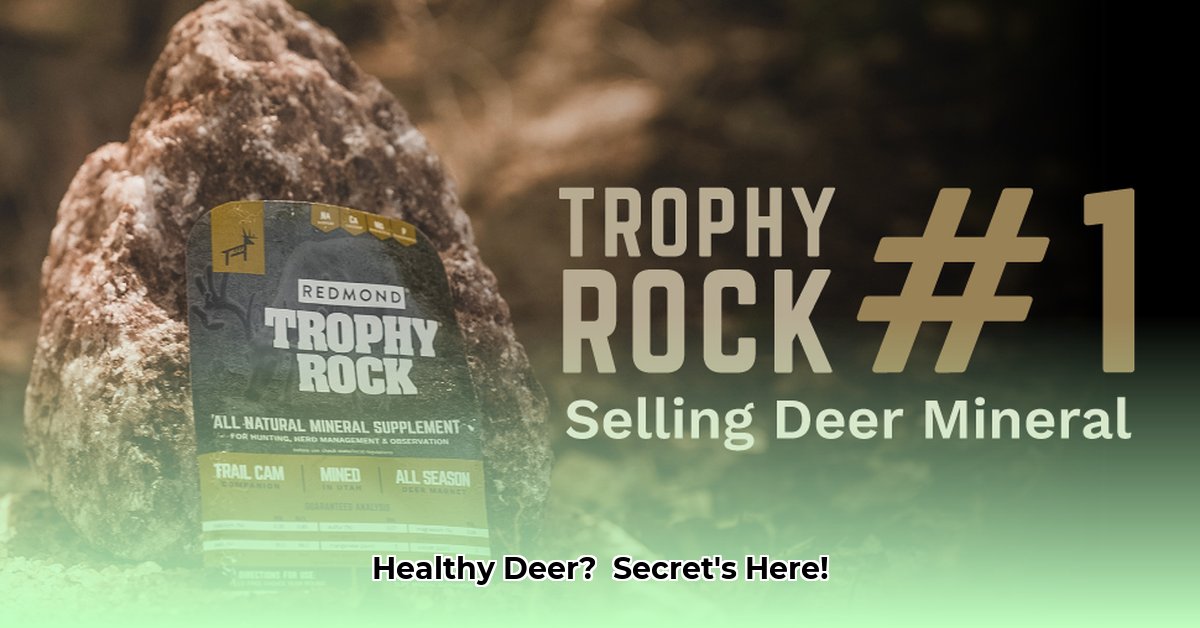
Deer Minerals from Tractor Supply: A Comprehensive Guide to Healthy Deer and Sustainable Wildlife Management
Improving deer health is crucial for maintaining a thriving deer population and a balanced ecosystem. Supplementing their diets with essential minerals can significantly impact their overall well-being, antler growth, and reproductive success. This guide provides a step-by-step approach to effectively using deer minerals from Tractor Supply, ensuring both deer health and environmental sustainability. For more information on deer mineral options, check out this helpful resource: Tractor Supply Deer Blocks.
1. Assessing Your Needs: Laying the Foundation for Success
Before purchasing any deer mineral supplement, it's vital to understand your deer herd's specific needs and the existing conditions in your area. This involves a thorough assessment that considers several key factors:
Soil Analysis: A soil test will reveal the nutrient composition of the soil where the deer forage. Identifying deficiencies in essential minerals like calcium, phosphorus, magnesium, and trace elements is the first step in determining which supplements are needed. Aren’t healthy, thriving deer a reflection of a healthy habitat? Understanding the soil composition helps you tailor supplementation precisely.
Deer Population and Condition: The size of your deer population directly impacts the quantity of minerals required. Observe the appearance of the deer: are they exhibiting signs of mineral deficiency, such as thin coats, poor antler development, or low reproductive rates? This helps you gauge the severity of any nutritional deficit. "We've seen significant improvement in deer health after implementing a targeted mineral supplementation program," says Dr. Emily Carter, Wildlife Biologist at the National Wildlife Federation.
Local Regulations: Remember to check state and local laws regarding wildlife feeding. Some areas restrict the types of minerals used or require specific permitting. Failing to comply can lead to penalties. Always prioritize legal compliance.
2. Choosing the Right Product: Navigating Tractor Supply's Offerings
Tractor Supply offers a variety of deer mineral supplements, each formulated with different mineral blends to address specific needs. Careful selection requires comparing several factors:
Ingredient Composition: Examine the mineral content of each product. Look for supplements that contain a balanced blend of calcium, phosphorus, magnesium, zinc, selenium, and other trace minerals essential for optimal deer health. Does the product cater to the specific deficiencies identified in your soil analysis?
Target Benefits: Different supplements address specific nutritional needs. Some focus on antler growth in bucks, while others support reproductive health in does. Selecting the right blend can maximize its impact.
Customer Reviews: Reading reviews from other users can offer valuable insights into the effectiveness of different products under various conditions. What experiences have others in your region had? This peer feedback can help inform your decision.
3. Proper Placement and Application: Maximizing Effectiveness and Minimizing Waste
Strategic placement of mineral supplements is essential for maximizing their effectiveness and minimizing potential environmental impacts:
Site Selection: Choose locations away from water sources to prevent contamination. The site should be easily accessible to deer but also protected from predators and weather. Consider using multiple, smaller stations rather than a single, large pile to encourage even distribution. Using elevated feeders is an effective way to protect the minerals from moisture and prevent waste.
Distribution: Spread the minerals evenly across the chosen area to prevent overcrowding and ensure all deer have access. Avoid creating piles that could attract undesired wildlife.
Maintenance: Regularly check mineral levels and refill as needed to ensure a consistent supply. Proper maintenance minimizes waste and keeps deer consistently supplied with vital nutrients.
4. Monitoring and Adjustment: A Continuous Improvement Process
Regular monitoring of the mineral sites and the deer's health is critical for long-term success. This allows for timely adjustments to optimize the supplementation strategy:
Site Observation: Regularly check the mineral sites. Note the level of consumption, any signs of spoilage, or the presence of other animals. Is the mineral supply being used regularly? Are there any signs of depletion? Answering these questions guides further actions.
Deer Health Assessment: Observe the deer's overall health, noting any improvements or continuing deficiencies. Are the deer exhibiting healthier coats, improved antler growth, or increased reproductive success?
Adaptive Management: Based on your observations, adjust supplementation levels, product selection, or mineral site locations to address any identified issues. Does the supplement need replacement, is the distribution location optimal, or do you need to adjust quantities? Flexibility and detailed observation are key.
5. Considering the Wider Ecosystem: Responsible Environmental Stewardship
While focusing on deer health is crucial, it's equally important to consider the potential impact of mineral supplementation on the wider ecosystem.
Potential Impacts: Excess minerals can affect soil and water quality and may attract unintended wildlife. How might the mineral supplementation impact the surrounding environment?
Mitigation Strategies: Mitigate these risks by responsibly managing mineral placement and usage. Regular monitoring and consideration of the overall environmental impact is key. This encompasses appropriate site selection, controlled distribution, and awareness of surrounding fauna.
6. Legal and Regulatory Considerations: Staying Compliant
Before implementing any deer mineral supplementation program, meticulously review all relevant local and state regulations. Knowledge of regulations prevents penalties and demonstrates responsible wildlife management practices. Check with your local wildlife agency for specific guidelines.
This comprehensive guide empowers you to effectively improve deer health while safeguarding both the deer population and the surrounding environment. Remember, responsible wildlife management is an ongoing process that requires continuous monitoring, adaptation, and a commitment to sustainable practices.